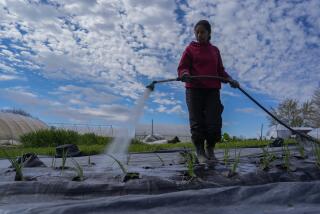Prices Paid to Farmers Rise 2.4% : Pay Trails 1984 Level Despite 2nd Straight Monthly Gain
WASHINGTON — Prices that farmers get for raw products rose 2.4% in November, the second increase in a row for the monthly index, the Agriculture Department said Friday.
But even with the back-to-back increases, farm commodity prices, on the average, were still 7.4% below a year ago. Department economists say that no major recovery is in sight and that the farm economy will remain sluggish at least through the first half of 1986.
The report said higher prices for cattle, broilers, corn, strawberries and oranges were mostly responsible for the November increase. Lower prices for lemons, hogs and grapefruit partly offset the gains for the other items.
According to department records, the rise in the price index this fall is the first since July, 1984.
Prices held even for several months last winter but dropped steadily until September, when they began leveling off. They rose in October and November.
Meanwhile, prices that farmers paid in November to meet expenses rose 0.6% from October but were still down 0.6% from a year ago. The increase was due mainly to higher prices for feed and feeder livestock, the department said.
Department economists said earlier this week that prices of livestock and crops have declined so much this year that farmers will get about 32 cents of each consumer dollar spent on food, the smallest share in more than 50 years.
The November price report showed that the farm prices of livestock and livestock products were up 3% from the October index but still averaged 3.5% below a year ago. Crop prices were up 2.7% from October but averaged 12% below the year-earlier average.
Department economists say farm income is expected to drop this year to a range of $25 billion to $29 billion from last year’s $34.5 billion. Food prices are expected to rise slightly more than 2%, compared to a 3.8% gain in 1984.
According to the preliminary November figures, based primarily on mid-month averages, the price index for meat animals was up 3.6% from October but still averaged 2.1% below a year earlier.
Cattle prices were up $2.90 per 100 pounds from October, but hogs dropped 90 cents per hundredweight.
Overall, November farm commodity prices averaged 126% of a 1977 base used for comparison, according to the preliminary figures. That was up 3 percentage points from October average of 123%. In November, 1984, the index stood at 136%.
In August, the index dropped to 121%, which was the lowest since November, 1978, when it averaged 119%.
The November parity ratio was 51%, up one point from October and two points above September, when it sank to 49% and tied for the record low reached, according to department records, in June, 1932, during the depths of the Depression.
Many economists say the old parity standard is outmoded because it doesn’t take into full account changes in farm productivity. But others contend that the ratio remains useful in comparing year-to-year changes.
Under the parity formula, prices that farmers get for commodities are compared to prices that they pay to meet expenses. It then uses a 1910-14 measurement to express what happened. At 100%, the indicator would theoretically mean that farmers had the same buying power as they did in 1910-14.
More to Read
Inside the business of entertainment
The Wide Shot brings you news, analysis and insights on everything from streaming wars to production — and what it all means for the future.
You may occasionally receive promotional content from the Los Angeles Times.










